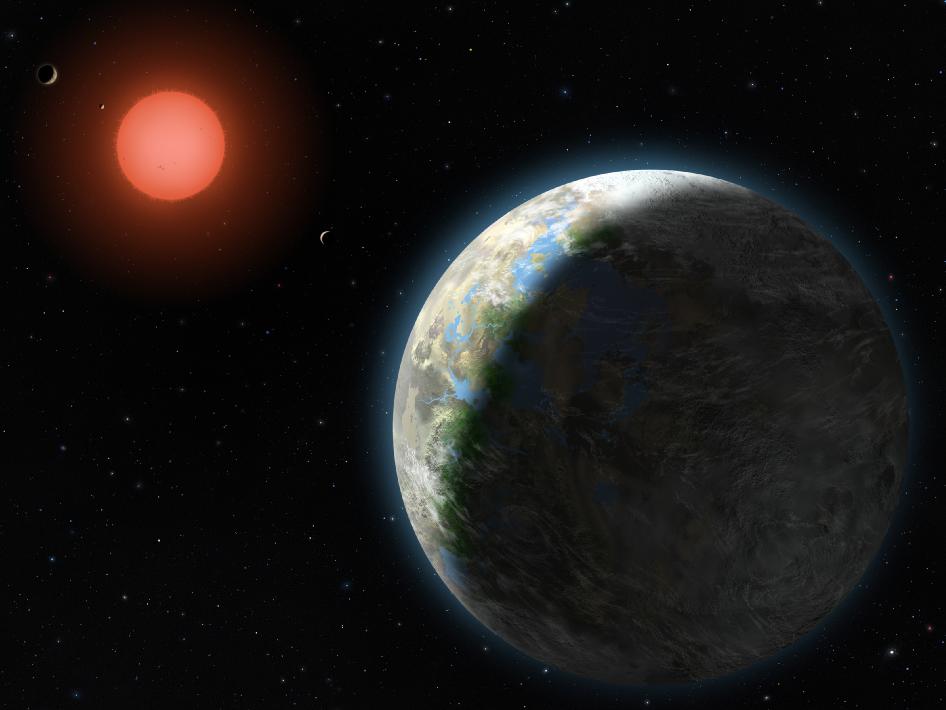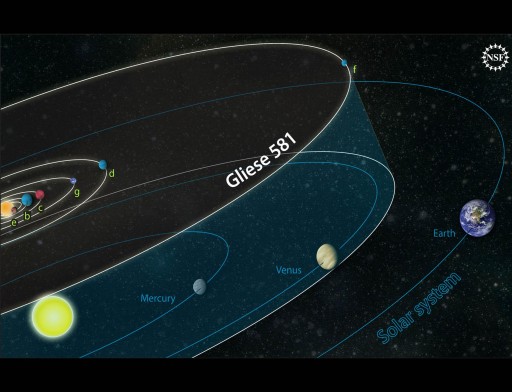First Potentially Habitable Exoplanet found
September 30, 2010
A team of planet hunters from the University of California (UC) Santa Cruz and the Carnegie Institution has announced the discovery of a planet, Gliese 581g, with three times the mass of Earth orbiting a nearby star at a distance that places it squarely in the middle of the star’s “habitable zone.”

Planets of the Gliese 581 System: This artist's conception shows the inner four planets of the Gliese 581 system and their host star, a red dwarf star only 20 light years away from Earth. The large planet in the foreground is the newly discovered GJ 581g, which has a 37-day orbit right in the middle of the star's habitable zone and is only three to four times the mass of Earth, with a diameter 1.2 to 1.4 times that of Earth. (Lynette Cook)
The research, sponsored by NASA and the National Science Foundation, placed the planet in an area where liquid water could exist on the planet’s surface. If confirmed, this would be the most Earth-like exoplanet yet discovered and the first strong case for a potentially habitable one.
The new findings are based on 11 years of observations of the nearby red dwarf star Gliese 581, using the HIRES spectrometer on the Keck I Telescope. The spectrometer allows precise measurements of a star’s radial velocity (its motion along the line of sight from Earth), which can reveal the presence of planets. The gravitational tug of an orbiting planet causes periodic changes in the radial velocity of the host star. Multiple planets induce complex wobbles in the star’s motion, and astronomers use sophisticated analyses to detect planets and determine their orbits and masses.
The researchers discovered two new planets around Gliese 581. This brings the total number of known planets around this star to six, the most yet discovered in a planetary system outside of our own. Like our solar system, the planets around Gliese 581 have nearly circular orbits.

Comparing the Gliese 581 to Our Solar System: The orbits of planets in the Gliese 581 system are compared to those of our own solar system. The Gliese 581 star has about 30% the mass of our sun, and the outermost planet is closer to its star than we are to the sun. The fourth planet, G, is a planet that could sustain life. (National Science Foundation/Zina Deretsky)
The new planet has a mass three to four times that of Earth and orbits its star in just under 37 days. Its mass indicates that it is probably a rocky planet with a definite surface and enough gravity to hold on to an atmosphere.
Gliese 581, located 20 light years away from Earth in the constellation Libra, has two previously detected planets that lie at the edges of the habitable zone, one on the hot side (planet c) and one on the cold side (planet d). While some astronomers still think planet d may be habitable if it has a thick atmosphere with a strong greenhouse effect to warm it up, others are skeptical. The newly-discovered planet g, however, lies right in the middle of the habitable zone.
The planet is tidally locked to the star, meaning that one side is always facing the star and basking in perpetual daylight, while the side facing away from the star is in perpetual darkness. One effect of this is to stabilize the planet’s surface climates, according to Steven Vogt, a professor of astronomy and astrophysics at the University of California, Santa Cruz. The most habitable zone on the planet’s surface would be the line between shadow and light (known as the “terminator”).
“Personally, given the ubiquity and propensity of life to flourish wherever it can, I would say, my own personal feeling is that the chances of life on this planet are 100 percent,” said Vogt in a press conference.
The team’s new findings are reported in a paper published in the Astrophysical Journal and posted online.
More info: NASA news